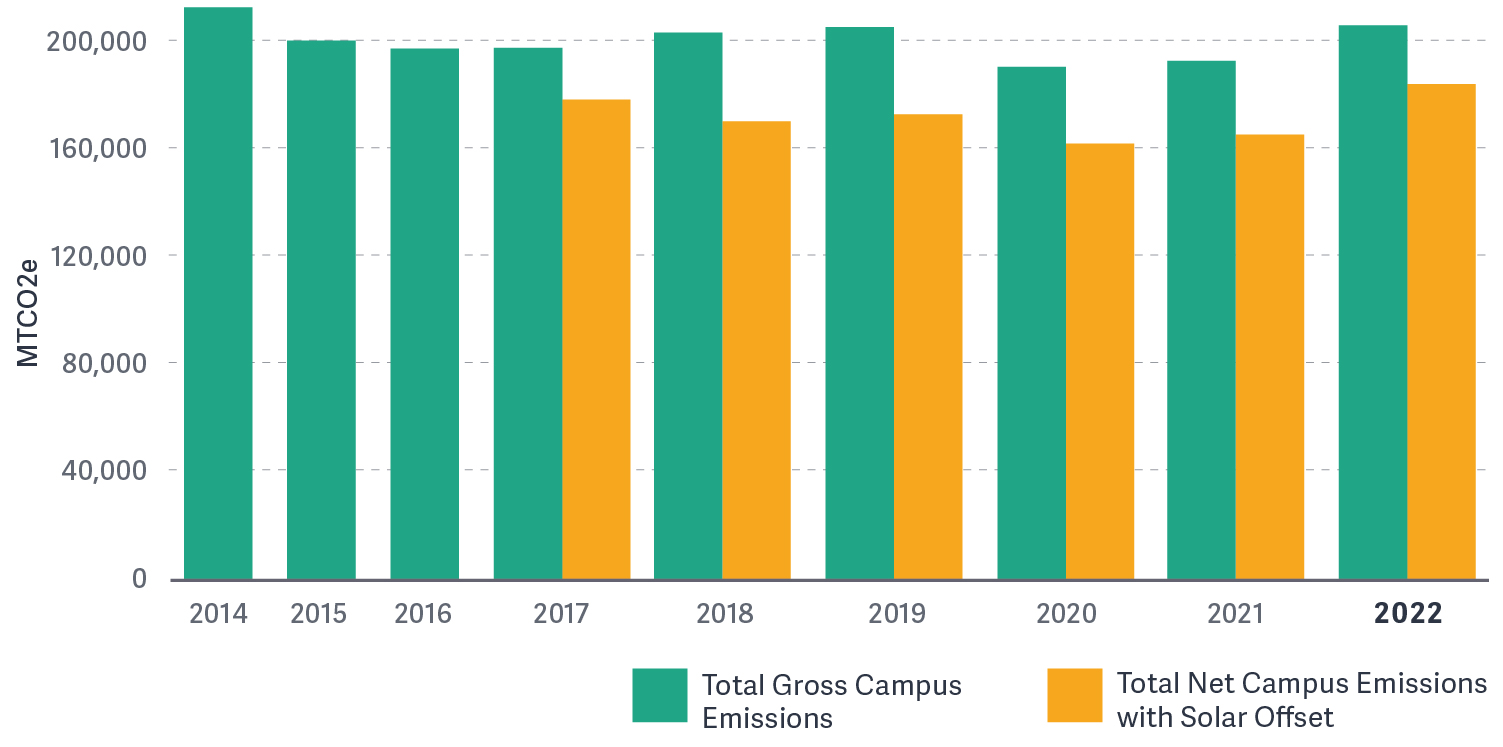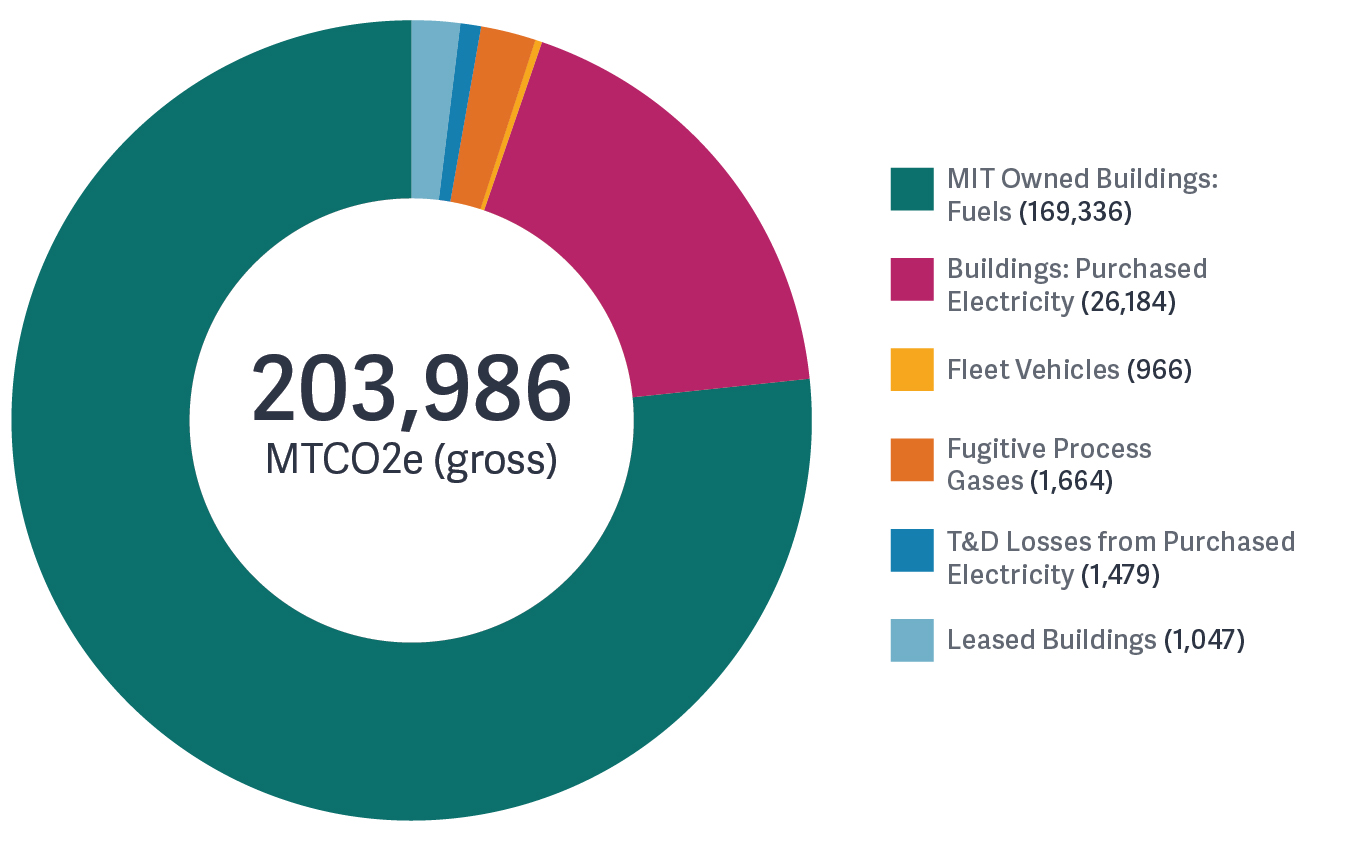The Path Toward 2050
Fast Forward: MIT’s Climate Action Plan for the Decade includes two major campus goals—a net-zero emissions MIT by 2026 and the goal of eliminating direct campus emissions by 2050. To meet the 2026 target, and ultimately achieve zero direct emissions by 2050, the Institute is making its campus buildings dramatically more energy efficient, transitioning to electric vehicles (EVs), and enabling large-scale renewable energy projects, among other strategies.

Fiscal Year 2022 Update
Progress toward decarbonizing a dynamic campus like MIT highlights the often-non-linear path of reducing emissions. As the campus grows and needs evolve, emissions fluctuations are both expected and managed for, but the ultimate goal of a zero emissions MIT—and the work toward it—remains unchanged. In fiscal year 2022, there was a 5% increase in total on-campus emissions over the previous year. In this same time, MIT’s solar power purchase agreement (PPA) in North Carolina enabled the Institute to offset 11% of its total on-campus emissions.
The overall increase in energy demand on campus—and resulting increase in emissions—was driven in part by a repopulation of campus, new campus growth (related to the New Vassar, the MIT Museum, expansion of Building 4, and reopened Hayden Library), pandemic related safety measures, such as higher building ventilation rates, and testing energy required for the new central plant commissioning. In addition, less solar energy was produced through our North Carolina solar PPA in fiscal year 2022, contributing to an increase in MIT’s total net emissions. MIT continues to focus on reducing direct energy use and the resulting emissions as the campus transforms and grows to meet the mission of the Institute.
This year MIT committed to its fourth, multi-year partnership agreement with local utility company Eversource. The program—known as Efficiency Forward—was designed in 2010 to create an enhanced energy efficiency incentive program, creating a win-win situation where MIT could invest in more energy conservation projects and lower energy consumption on campus. Since its inception, the program has executed nearly 300 projects for a total calculated savings of approximately 70 million kilowatt hours and 4.2 million therms, playing a key role in MIT’s goal to reduce overall carbon emissions.
Despite a 7.5 percent increase in MIT’s campus building space since 2014 (equivalent to growth of 1 million gross square feet) the Institute reduced campus emissions over the same period by 5 percent via building energy retrofits and other efficiency measures, fuel switching from oil to natural gas and grid improvements. Including the impacts from solar energy purchases, MIT has reduced its net emissions by 15 percent since 2014.

Building Energy Efficiency
Current efficiency efforts focus on reducing energy use in 20 buildings that account for more than 50 percent of MIT’s energy usage. One such project underway is Building 46—home to MIT’s brain and cognitive sciences research—one of the largest energy users on campus. Efforts include optimizing ventilation systems to significantly reduce energy use while improving occupant comfort and working with lab managers to implement programs such as fume hood hibernation and equipment adjustments. For example, by raising ultralow freezer set points by 10 degrees users can reduce their energy consumption by as much as 40 percent and not compromise performance. Together, these measures are projected to yield a 35 percent reduction in emissions for Building 46 and contribute to reducing campus-wide emissions by 2 percent.
Getting to Net-Zero with Renewable Energy Projects
Building on the success of the 2016 Summit Farm Power Purchase Agreement (PPA) that enabled the construction of a 650-acre, 60-megawatt solar farm on fallow farmland in North Carolina, MIT continues to advance collaborative opportunities to enable the development of new, largescale renewable energy projects and accelerate the de-carbonization of regional electricity grids. In 2022, through the purchase of 76,406 megawatt hours of solar power from Summit Farms, MIT offset over 22,000 metric tons carbon dioxide equivalent (MTCO2E) from on-campus operations.
Visualizing Scope 3 Emissions to Drive Change
The MIT Office of Sustainability has been working in partnership with researchers and staff alike, to capture a more complete picture of indirect, or Scope 3, emissions involved in operating the Institute such as purchased goods and services, MIT-sponsored travel, commuting, waste, and capital goods.


